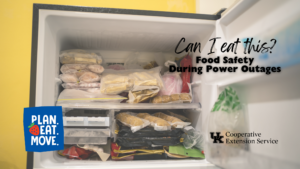
Bad weather is just one of many reasons the power could go out. When there are power outages, it is important to have a plan for keeping foods safe. Food items stored in the refrigerator or freezer can easily spoil or become harmful to eat if they are not kept at safe temperatures. Here are some quick tips to help your family keep foods safe and cold during power outages.
Keep doors to the refrigerator and freezer closed as much as possible. This will help maintain the cold temperatures inside. An unopened refrigerator can keep foods safe for up to 4 hours, and a full, unopened freezer can maintain a safe temperature up to 48 hours (24 hours if only half full).
If you expect the power outage to last longer than four hours, dry ice or blocks of ice can be place in the refrigerator and/or freezer to keep it cold. Fifty pounds of dry ice should hold an 18-cubic-foot full freezer for two days. It is also a good idea to keep coolers on hand. Coolers, frozen ice packs, and ice on hand are easy ways to keep foods cold if the power is out for longer periods.
It is not a good idea to store foods in the snow or outside even if the temperatures are very cold. The sun can warm foods to an unsafe temperature. Foods could also be exposed to animals or other sources of bacteria. It is a better idea to take advantage of the cold temperatures to make your own ice by freezing water-filled bottles, jugs, or buckets. Add the ice to your refrigerator, freezer, or cooler to keep it cold.
Never guess whether food is safe. You cannot tell if food is safe by taste, appearance, or odor. The best way to know whether your foods are safe is to keep a thermometer in your refrigerator and freezer. Safe temperature readings are at or below 40 degrees Fahrenheit for the refrigerator and at or below zero degrees Fahrenheit for the freezer. If foods are stored in a cooler or there is not an appliance thermometer, check each individual food item using a digital, dial, or instant read food thermometer. Foods that are 40 degrees Fahrenheit or below are safe to keep. Most food items can be refrozen even if they have become partially thawed. Although safe, this can affect the quality of the food.
References:
United States Department of Agriculture. (2013). Keeping Foods Safe during Emergencies. Retrieved from https://www.fsis.usda.gov/wps/portal/fsis/topics/food-safety-education/get-answers/food-safety-fact-sheets/emergency-preparedness/keeping-food-safe-during-an-emergency/CT_Index
Source: Amy Singleton, RDN, NEP Area Agent for District 2
BeFoodSafeDuringEmergencies-Booklet


Find more information here: https://www.ready.gov/food#power
